
Christoph Waltz is an Austrian actor. He is known for playing villainous and supporting roles in English-language films since 2009. He has been primarily active in the United States. His accolades include two Academy Awards, two Golden Globe Awards, two BAFTA Awards, and two Screen Actors Guild Awards.

Drasteria is a genus of moths in the family Erebidae.

Drasteria cailino is a moth of the family Erebidae first described by Alexandre Louis Lefèbvre de Cérisy in 1827. It is found in southern Europe, the Near East and Middle East up to the western Himalayas in the east. In the Levant, several isolated populations are present in Lebanon, Syria and Israel.

Drasteria adumbrata, the shadowy arches, is a moth of the family Erebidae. The species was first described by Hans Hermann Behr in 1870. It is found from coast to coast in southern Canada, south in the west to California and Colorado, south in the east to New England and Michigan. Subspecies D. a. alleni is found from eastern Alberta to New York and Nova Scotia. Subspecies D. a. saxea occurs from southern British Columbia and south-west Alberta south to California and Colorado.
Drasteria hastingsii is a moth of the family Erebidae. It is found from British Columbia south to Oregon and California.
Drasteria tejonica is a moth of the family Erebidae. It has been recorded from California, Arizona, Colorado, Utah and New Mexico.
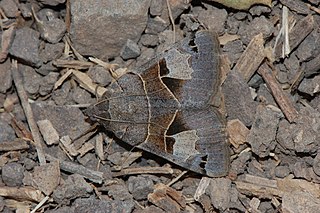
Drasteria edwardsii is a moth of the family Erebidae. It is found from Washington, through Oregon to California.

Drasteria fumosa, the smoky arches, is a species of moth in the family Erebidae first described by Strecker in 1898. It is found from the US state of California east to Utah and Texas.
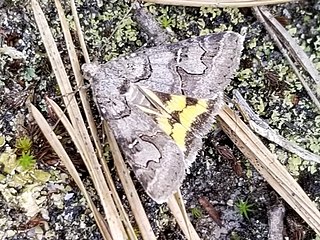
Drasteria graphica, the graphic moth, is a moth of the family Erebidae. The species was first described by Jacob Hübner in 1818. It is found in the United States in coastal dunes from Maine to Florida, west to Mississippi. It is also found along the shores of the Great Lakes in Michigan and Wisconsin. Subspecies D. g. atlantica is listed as threatened in Connecticut.

Eumunida picta is a species of squat lobster found in the deep sea. The species is strongly associated with reefs of Lophelia pertusa, a deep-water coral, and with methane seeps. It is abundant in the western Atlantic Ocean, where it is found from Massachusetts to Colombia.

Ashtoret is a genus of crabs in the family Matutidae, containing the following species:
Drasteria yerburyi is a moth of the family Erebidae. It is found in Somalia, Eritrea, the United Arab Emirates, Yemen and Iran.

Drasteria caucasica is a moth of the family Erebidae. It is found in Romania, north-eastern Bulgaria, southern Moldova, southern Ukraine, Russia, Kazakhstan, Turkey, Daghestan, Armenia, Iraq, Iran, Turkmenistan, Uzbekistan, Tajikistan, Afghanistan, Pakistan, Kyrghyzstan, China and Mongolia.
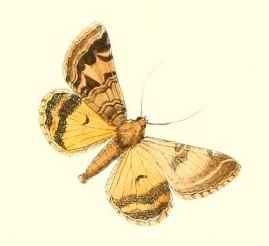
Drasteria langi is a moth of the family Erebidae. It is found in Afghanistan, Kyrghyzstan, Kazakhstan and Tajikistan.
Drasteria occulta, the occult drasteria moth, is a moth of the family Erebidae. The species was first described by Henry Edwards in 1881. It is found in North America, where it has been recorded from coastal areas in Maine, New Jersey, Pennsylvania and Texas. It is listed as a species of special concern and believed extirpated in the US state of Connecticut.

Drasteria sesquistria is a moth of the family Erebidae. It is found in Russia, Kazakhstan, Afghanistan, Uzbekistan, Tajikistan, Kyrgyzstan, Turkmenistan and Mongolia.
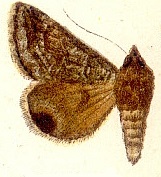
Drasteria tenera is a moth of the family Erebidae. It is found in Russia, Kazakhstan, Kyrgyzstan and China (Tibet).
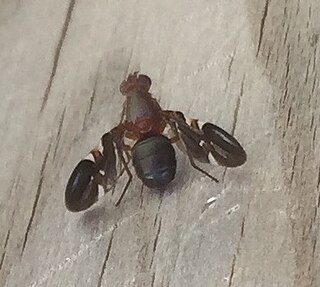
Delphinia picta is a species of picture-winged fly in the family Ulidiidae. The specific name picta is from Latin and means "painted." It is the only species in the monospecific genus Delphinia. It is found in the United States on the East Coast and in the Midwest from Florida to Maine across to Kansas through Minnesota but also can be found in Mexico and El Salvador. It is sometimes mistaken for a species of fruit fly, but D. picta do not feed on living plant matter, as they are detritivores and eat decaying plant matter. They also have been observed eating fermenting frass from Megacyllene robiniae on black locust trees. They can be found almost anywhere there is decaying vegetation: landfills, temperate deciduous forests, swamps, and even shaded fields.














